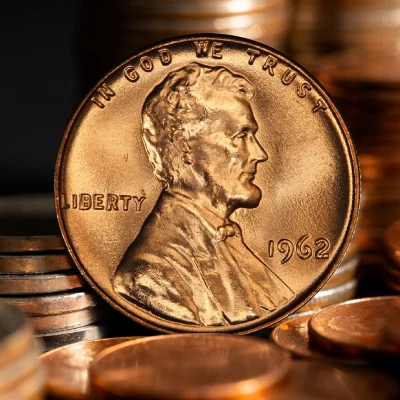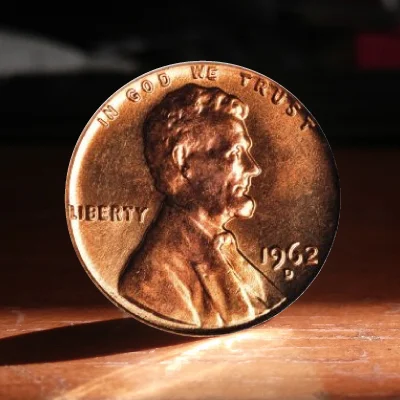The unassuming penny, so readily overlooked in our wallets and forgotten in
jars, can at times possess secret value. Although most contemporary one-cent
coins are really worth, well, a cent, some years and specific characteristics
can actually make their value balloon for coin collectors. We're going to
break open the 1962 Lincoln Cent—a penny that could really surprise you.
To the common man, a 1962 penny is just a copper cent coin. But to collectors,
knowing its subtleties can reveal to us whether it’s a run-of-the-mill
circulation find or worth a collection. Let’s break down everything you need
to know about the value of the 1962 penny.
To the common man, a 1962 penny is just a copper cent coin. But to collectors,
knowing its subtleties can reveal to us whether it's a run-of-the-mill
circulation find or worth a collection. Let's break down everything you need
to know about the value of the 1962 penny.
The Basics: What is a 1962 Penny?
The unassuming penny, so readily overlooked in our wallets and forgotten in
jars, can at times possess secret value. Although most contemporary one-cent
coins are really worth, well, a cent, some years and specific characteristics
can actually make their value balloon for coin collectors. We're going to
break open the 1962 Lincoln Cent—a penny that could really surprise you.
To the common man, a 1962 penny is just a copper cent coin. But to collectors,
knowing its subtleties can reveal to us whether it’s a run-of-the-mill
circulation find or worth a collection. Let’s break down everything you need
to know about the value of the 1962 penny.
To the common man, a 1962 penny is just a copper cent coin. But to collectors,
knowing its subtleties can reveal to us whether it's a run-of-the-mill
circulation find or worth a collection. Let's break down everything you need
to know about the value of the 1962 penny.
The Basics: What is a 1962 Penny?
The 1962 Lincoln Cent coin has Abraham Lincoln on the obverse (front) with
"LIBERTY" and the date, and the Lincoln Memorial on the reverse (back).
Observe the motto "E PLURIBUS UNUM" (or PLURIBUS UNUM) on the reverse, along
with "ONE CENT" and "UNITED STATES OF AMERICA."
The obverse has the motto "IN GOD WE TRUST." Throughout the period, Lincoln
cents continued to be made up of 95% copper and 5% zinc, the same
percentages that imparted the reddish-brown color.
Key Factors Determining 1962 Penny Value
Several factors influence the value of any coin, and the 1962 penny is no
exception.
Mint Mark:
-
This is significant: The 1962 penny was made in
two different United States Mint plants:
-
Philadelphia (No Mint Mark): Pennies minted in
Philadelphia lack a mint mark.
-
Denver (D Mint Mark): Pennies minted in Denver
feature a small "D" letter stamped below the date on the obverse.
Most of the 1962 pennies were made by Philadelphia. Denver made fewer, yet
both are abundant in low grades.
Condition (Grade):
The most important of all. The higher the condition, the greater the value.
Coin grading is a technical exercise, but anyone can see the general
categories. The finest specimens are in Mint State (MS) condition, i.e., they
are not worn and retain their original shine.
MS has sub-grades (e.g., MS-60 to MS-70), with MS-70 being a perfect coin.
PCGS and NGC are trusted grading services that grade the coins for value,
placing much value on their worth.
Luster:
In uncirculated coins, the mint luster (the brightness of the coin when
originally minted) adds much to its value and attractiveness.
Toning/Color:
Natural copper oxidation can result in a range of colors from brown through
firm red and blues. Although some collectors prefer original red (RD) coins,
nice uniform toning may sometimes be desirable.
Errors and Varieties:
Here's where the "needle in a haystack" comes into play. Errors are
mis-strikes that take place during minting, and varieties are deliberate
changes or deviations from the die. The known errors on the 1962 penny are
fairly rare, but always be on the lookout for:
-
Doubled Dies (DDO/DDR): When the design is
doubled. It might be subtle or very apparent.
-
Off-Center Strikes: Where the coin planchet is not
centered when struck.
-
Repunched Mint Marks (RPMs): Where a mint mark was
double struck and a slight overlap remains.
-
Die Cracks/Cuds: Less frequent for high
denomination, but exciting finds.
1962 Penny Values—What to Expect
Now let's go back to the numbers. Keep in mind that these are estimates and
will vary with market demand, dealer premiums, and the real condition of the
coin. Professional grading is advised for accurate appraisals.
1962 (Philadelphia—No Mint Mark)

-
Circulated Condition (G-XF): Most circulated
pennies minted in 1962 will be face value (1 cent) or perhaps a little
higher, as much as $0.05-$0.25. Copper melt value may even be slightly
higher than face value, but it is illegal to melt
U.S. coins
for the metal content.
-
About Uncirculated (AU): An AU 1962-P may be
worth $0.50-$1.50.
-
Uncirculated (MS-60 to MS-63): Lower
uncirculated grades would have prices in the range of $2 to $5.
-
High-End Uncirculated (MS-64 to MS-66): Now
the price increases here. A very select 1962-P in MS-65 Red (RD) would
bring $15-$30.
-
Gem Uncirculated (MS-67 and higher): These are
extremely rare and will be worth much more, to the tune of $100+ for
examples that are flawless with full original red luster. It is
extremely hard to find a coin superior to MS-67; few are even reported
to exist and they cost thousands of dollars.
1962-D (Denver Mint Mark)

Circulated Condition (G-XF): As in the
Philadelphia mint, expect $0.05-$0.25.
Of Uncirculated (AU): $0.50 - $1.50.
Uncirculated (MS-60 to MS-63): Valued at $2-$5.
High-Grade Uncirculated (MS-64 to MS-66): A
1962-D in MS-65 Red (RD) could be in the $15-$30.
Gem Uncirculated (MS-67 and higher): Once more,
extremely scarce and costly, perhaps $100+. Although more lincoln cents
were made by the Denver mint in 1962, high-grade ones are scarcer than
their Philadelphia counterpart for this year.
Important Note on Red (RD), Red-Brown (RB), and Brown (BN) Designations:
When a copper coin is graded by professional graders (NGC, PCGS), they also
give a color grade:
RD (Red):
The coin has a minimum of 95% of its natural red copper color when minted.
These are the most prized and valuable.
RB (Red-Brown):
The coin is a combination of original red and rusty brown color, usually 5%
to 95% red.
BN (Brown):
The coin lost nearly all or even the entire original red tint and became
largely brown through oxidation.
A 1962 penny in MS-65 RD will be worth significantly more than an MS-65
BN.
Looking for Errors and Varieties
Though regular 1962 pennies in worn condition won't set you up for life,
discovering an error or a special variety can be exhilarating. Check the
date and lettering with a magnifying glass for doubling, or examine
off-center strikes where the planchet wasn't aligned exactly. Even small
mistakes can increase the value for error coin specialists by a few dollars.
Where to Sell or Get Your 1962 Penny Valued
If you think you have a worthwhile 1962 penny (particularly if it is
uncirculated or an apparent mint error):
Local Coin Shops:
They may give an on-the-spot appraisal and perhaps even make a cash bid for
your coins.
Coin Shows:
Good spot to receive a variety of opinions and view how other similar coins
are selling.
Professional Grading Services:
For potentially valuable uncirculated coins or possible errors, have your
coin graded by a professional third-party grading service such as PCGS
(Professional Coin Grading Service) or NGC (Numismatic Guaranty Company).
Their grade and authenticity will offer an impartial determination and
greatly increase the coin's liquidity and value in the collector market.
Their websites usually list quoted prices for their services.
Online Marketplaces:
eBay can be used to sell coins. Be careful of fees and needing quality
photos and truthful descriptions. eBay Partner Network is used by many
numismatic collectors to seek out and purchase coins.
Professional grading for higher-end coins is nearly a requirement to use
when selling online to build trust with customers. There are likely many
links to eBay auctions with prices listed on coin collector forums.
The Takeaway
The 1962 penny is, in general, a low-value coin with hardly anything more
than face value to speak of. Don't count it out entirely, however!
Uncirculated pennies, particularly those with complete original red luster,
will find a buyer for decent money from collectors.
And the very real chance of some unexplained error or variety keeps it
always worth a look. The next time you come across a 1962 penny, make sure
to study its obverse and reverse sides, verify the existence of the mint
mark, and consider its history as a Lincoln cent. You may be clutching a
piece of history with a story and worth of its own that you didn't
anticipate. Click here to learn more about collecting Lincoln pennies!
